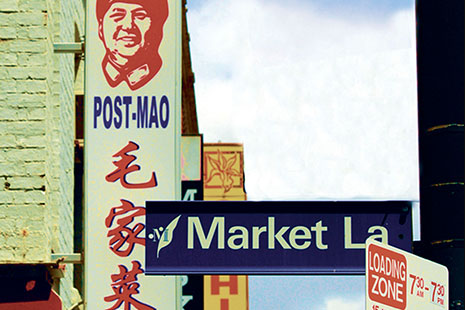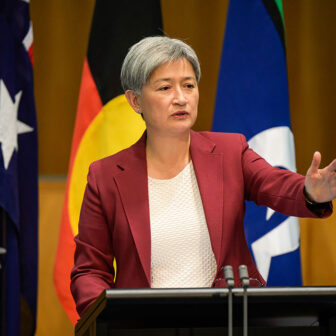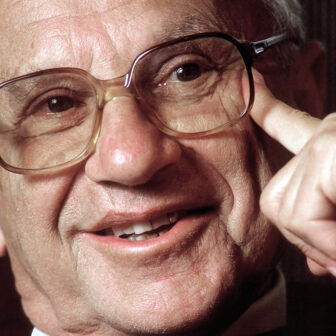Australia and China at 40
Edited by James Reilly and Jingdong Yuan | UNSW Press | $49.99
Australia and China at 40 is a book without a subtitle and without a preface. It is unusual to pick up a book that makes so little effort to explain how and why it came to be written. Fergus Hanson’s essay, “How Your Attitudes Help Shape Relations with China,” the ninth of the volume’s ten chapters, suggests why its significance should be obvious from the title. For Australians, China looms so large on the horizon that a majority has for years believed China’s economy to be the largest in the world. According to Hanson, Australians are virtually alone in the world in this conviction. It may be a flow-on effect from the strength of the Australian dollar, leading the greater number of us to mistake a weak US currency for a small US economy.
If the book were to have a subtitle, it would be “Between economy and security.” This is not the focus of every essay, but it reflects the contents as a whole as well as the reigning paradigm for any discussion of Australia–China relations. According to the editors, James Reilly and Jingdong Yuan, Australia’s “economic and security interests are diverging” as a consequence of the fact that, “for the first time in its history,” its major trade partner is not a democratic country. Correspondingly, Han Feng from the Chinese Academy of Social Sciences observes “tensions… in the bilateral relationship, affecting, for example, economic, cultural and security ties.” Nick Bisley thinks there is no need for such tensions: “It is perfectly possible for Australia to be able to enjoy good economic relations with the PRC and excellent military relations with the US…” John Lee is less sanguine, pointing to “the uncertainties of China’s rise” and the need for strategic measures to guard against undesirable outcomes.
If further evidence of this paradigm is needed, it can be found in recent debates in Australia. Hugh White’s book The China Choice, which urges the United States to share power with China in the Pacific, provoked a vitriolic response from the Australian’s foreign editor Greg Sheridan, demonstrating the heat likely to accompany any serious discussion of Australia’s strategic alternatives in the context of the rise of China. In a more measured comment on the same issue, the incoming head of Defence, Dennis Richardson, recently declared bluntly: “Our alliance is not for sale.” The comment appears to have been directed at billionaire businessman Kerry Stokes, who had complained about the impact of the American base in Darwin on business relations with China, and bigger billionaire James Packer, the part-owner of gambling interests in Macau, who at the same meeting said that Australia was “a less grateful friend” to China “than it should be.”
An overemphasis on this tension and especially on its novelty might convey the impression that Australia was absolutely cocooned from its region for more than two centuries. In fact, scholars are still groping for a balanced assessment of the actualities, which include a long and complex history of involvement with China through migration, trade, war and diplomacy. In his contribution to this book, “From Kapyong to Kapyong: A Cycle in Australia–China Economic Relations,” James Cotton concludes that “it would not be an exaggeration to suggest that for the period from 1788 to 2008, Australia was in the happy position of thriving within an uncontested Anglo-American hegemony, with economic and security components mutually reinforcing…” But as he himself shows, this bird’s-eye view fractures when it is viewed from closer at hand. In the 1930s, too, Australia was “dealing with a rapidly industrialising [East Asian] economy,” Japan, that was “vying for regional dominance.” And in 1964, when Australia was shaping up for combat against an enemy generally supposed to be backed by China, it was also shipping nearly half its wheat crop there. A Venn diagram of Australian economic and security interests over time would show that they have by no means always been perfectly matched.
That they are linked is easier to establish. The 1970s, as illustrated by James Curran’s chapter, marked a turning point in Australia’s security arrangements. In that decade leaders on both sides of Australian politics moved away from dependence on the United States. Whitlam offered China recognition in 1972 and developed a foreign policy based on an assessment of the security risks in Asia that was far more optimistic than anything emanating from the White House. Subsequently, Malcolm Fraser turned to China to provide a regional bulwark against the Soviet Union. During these years, as Curran notes, China was vying with Japan for the attention of first the Whitlam and then the Fraser governments. Reilly and Yuan present the seventies as a decade in which Australia “managed to deepen its economic integration within Asia while reinforcing the security alliance with the United States,” but this conclusion is slightly at odds with the drift of Curran’s chapter, which stresses the degree to which Australia was making decisions independent of and in some cases displeasing to the United States.
How the two interests might weigh up against each other in future cannot be predicted with any certainty . Michael Wesley seems to think that economics will win out. “Pretty much every country in this region has a major stake in the ongoing success of the Chinese economy,” he states, before putting a rhetorical question: “if another Tiananmen Square massacre happened tomorrow, how many countries in the region… would break off their trade and investment relationship with China?” The hypothetical choice here should arguably be between economic and other interests in a single country, not between human rights in China and economic issues elsewhere. Japan, one of China’s largest trading partners, has in recent weeks shown just how possible it is to risk economic interests for amour propre. The Japanese government’s nationalisation of two of the Diaoyu/Senkaku islands was a move calculated to “hurt the feelings of 1.3 billion Chinese people,” as China’s Foreign Ministry put it, and also to harm bilateral trade worth more than US$300 billion. What leverage has the PRC been able to exercise in these circumstances? Wesley suggests that “an offer by Beijing to forestall a move by its firms into components manufacturing could be highly compelling to a country whose industry would be heavily affected,” but fails to take into account that a country consists of more than the state. In the case of Japan, an elected mayor of Tokyo was prepared to buy the islands concerned if the Japanese government did not. Electoral politics can work against economic rationalism, and so can populist nationalism.
IN THE blurb for Australia and China at 40 Stephen FitzGerald describes the contents as “neither political nor polemical.” It is true that the contributors on the whole avoid becoming heated. Nonetheless, political sensitivities inherent in the relationship are clear from differences in the views expressed, arising in part from differences in national perspectives. The list of contributors shows that the authors, all male, include three from Chinese institutions and two others who are former Chinese nationals. Among the challenges of the China–anyplace relationship is establishing what can be said with impunity in any shared forum, especially by the Chinese representatives. China is a country where publishing an opinion can land the writer in trouble. For this reason, it can never be absolutely straightforward for a Chinese scholar to engage in a collaborative writing project, and politics is always implicated at some level.
One major difference of opinion is to be found in contrasting perceptions of who is doing best out of the relationship. Contributors from Chinese institutions are inclined to think that China is the underdog; those from Australian institutions tend to think that China is looming too large for comfort. Wesley sees China as doing very well indeed, with everyone else in the region in danger of becoming hostages to its rampant growth. “China’s scale,” he argues, “has allowed it to maintain a reasonably diversified economy and trading profile, while its neighbours’ economies are increasingly restructured around and dependent on their trade with China.” In contrast, Yu Chang Sen, from Zhongshan University in Guangzhou, sees China’s trade position vis-à-vis Australia as weak. His case is roughly as follows. China is highly dependent on Australia for resources needed to fuel its development, particularly iron ore, which it cannot buy elsewhere without sacrificing much in terms of efficient delivery. Australia, on the other hand, buys from China only things that it could easily buy from someone else – Vietnam or India, for example. Yu shows that the size of China’s trade deficit differs according to the data used: Chinese data shows a deficit nearly twice the size of that indicated by the Australian data. Further, Australia gets more out of the relationship because profit margins for iron ore have widened much more rapidly than profit margins for steel. Finally, Australian agriculture is very competitive, and would place pressure on China’s rural sector if allowed an open door through a free-trade agreement. And despite all these advantages, Yu complains, Australia indulges in “resource nationalism.”
Similarly, Ding Dou, from Peking University, points to the unfavourable terms of trade for China in the bilateral relationship. Central to this perception is the price of iron ore, in conjunction with China’s heavy dependence on Australia as a supplier. Strategies to diversify supply have “met with only marginal success.” Australia, Ding observes, has its own problems, such as the “Dutch disease” arising from a growing over-dependence on Chinese demand for mining products. It has survived the global financial crisis for reasons largely to do with China’s economy, but it is not proving particularly competitive in the non-resources sector.
For Ding Dou, banks are a good example of Australia’s weakness. To quote: “the big three banks in China… now rank as the top three banks in the world in terms of market value. And for the time being, it is Chinese banks that are opening up business investment in Australian resources. In contrast, there is little sign that Australia’s big four banks have taken a foothold in China.” The picture emerging here is of a well-resourced but small and otherwise not very competitive country. Ding mentions the concern in China that “Australian restrictions [on foreign direct investment] are politically motivated” but doesn’t appear to recognise comparable Australian concerns about dealing with China.
What are these concerns? Nick Bisley notes that “when dealing with a Chinese firm one can never be entirely confident that one is dealing simply with a profit-maximising concern.” Unlike a Canadian firm, for example, a Chinese firm is “likely to be suffused with statist interest.” Indeed, China’s major enterprises, including the “big three banks” Ding mentions, are in the main state-owned. Their competitiveness is won at the cost of competitiveness in private enterprise in China, affecting both local and foreign firms. John Lee points out that “three-quarters of all formal finance (ie. bank loans) go to the country’s 130,000 SOEs.” Of these, the 150 leading enterprises, centrally managed, “own two-thirds of all fixed assets in the country while their combined revenues amount to about half of the revenues generated by all publicly and privately owned Chinese firms each year.” This state-owned complex constitutes a mountainous obstacle to foreign investment, compared to which the Australian Foreign Investment Review Board, much vilified by Chinese critics, is as a molehill.
A second area of difference lies in views of the security environment. You Ji’s chapter, “Managing Off-Balance Tripartite Relations: How to Avoid Unnecessary Confrontation,” presents a sustained critique of Australia’s defence policy, with particular reference to the 2009 Defence White Paper, which identified China as a threat. He sees the perception of a “threatening China” as inherent to a pathology characterised by a “tyranny of distance” mentality. This view of the world “may prove to be inadequate,” he writes, to deal “with a complicated process of regional order restructuring as a result of the economic redistribution of power.” Australia emerges from his discussion as hostage to its own historically grounded security anxieties, which lead it, arguably against its own interests, to cling to a US-centred defence system. Beijing, by contrast, has dealt “wisely” with Australia, even in the face of provocation. China “holds the view,” according to You Ji, “that major powers differ in political systems and security interests, but that all face a common need to foster economic prosperity.”
John Lee does not directly take issue with this juxtaposition of anxious Australia, but presents a very different China in a more complex strategic environment. First, countering a general tendency to accept China’s growth as a natural and self-described “peaceful” rise, he identifies China with the Chinese Communist Party and a geopolitical program: “China under the CCP is predisposed to seek leadership of Asia and to recast the regional order according to its preferences.” Quoting his own very quotable phrase, “the loneliest rising power in world history,” he portrays a China that has failed to develop allies in the region. It is rising moreover, “within an order that is now characterised by ‘democratic community’ as one of its key pillars,” and that is favourable, in terms of national dispositions, to maintaining American pre-eminence in the region. Within the region China has proved unable to exercise economic leverage, not least because “at least half and perhaps as much as two-thirds of its trade with East and Southeast Asia is ‘processing’ trade.” What Wesley sees as regional dependence on, indeed capture by, the Chinese economy, Lee sees as China’s dependence on the rest of Asia. He warns against the hope that a friendly China will be a loyal friend. Its “willingness to ‘reward’ strategic friends,” he counsels, “is as elusive as its capacity to ‘punish’ potential strategic competitors.”
LEE’s is among the more thought-provoking of the contributions to a book that is generally useful for marking where Australia and China sit in relationship to each other forty years after recognition. The authors are mostly concerned either with the structure of the economic relationship or with the implications of that relationship for defence and security. Non-traditional security, people-to-people relations, cultural exchange, migration, tourism, education: these are among the many aspects of the forty-year history that are not touched on at all. It must be concluded that they did not fall into the scope of the book as planned.
A preoccupation with the tripartite relationship between Australia, China and the United States is overwhelmingly apparent in the book. The rest of the region, and the world, form a pale backdrop. But it is likely that Australia’s actions and reactions in regard to both China and the United States are not totally peculiar to itself but consistent with global trends. Recently the Guardian published an article by Jonathan Kaiman called “Maple Leaf Ragged: What Ails Canada?” No Australian reading this could fail to recognise the key phrases – “undercurrent of anxiety,” “harsh crackdown on illegal immigrants,” “increasingly toeing the US line” in foreign relations, “adjusted environmental policy” and so on – or to identify with the issues raised. Canada has its Afghanistan, its Indigenous population, even its Pauline Hanson, who is there called Pauline Marois.
It is worth recalling that Canada established relations with China in 1970, two years before Australia. Jenny Hocking discusses the implications for Australia in the first volume of her biography of Gough Whitlam. In brief, Canada, as a wheat producer, was able to supplant Australia as a provider to China. In 1971, Hocking records, China failed to renew the Australian Wheat Board’s $100 million contract. That hotbed of radicalism the Victorian Farmers’ Union, passed a motion urging the McMahon government to recognise China. The rest, as they say, is history. •




